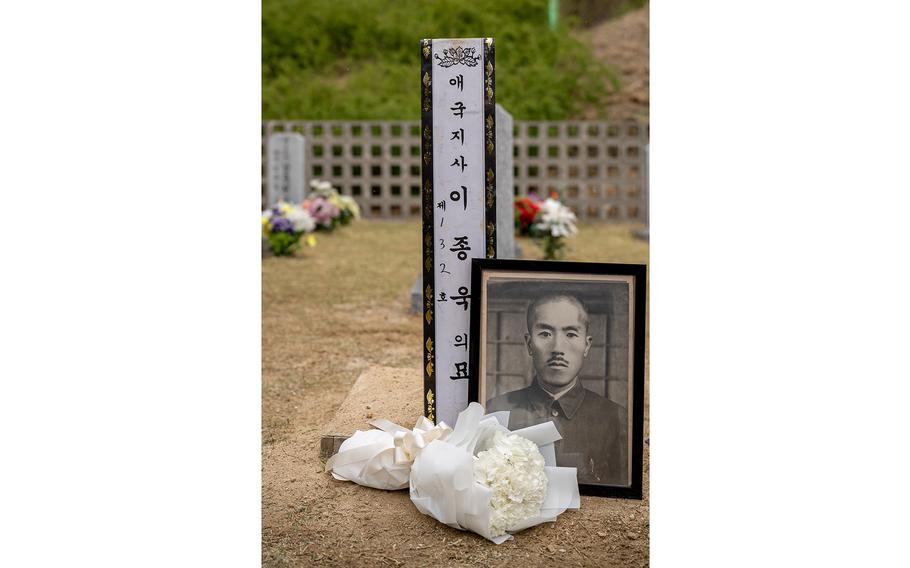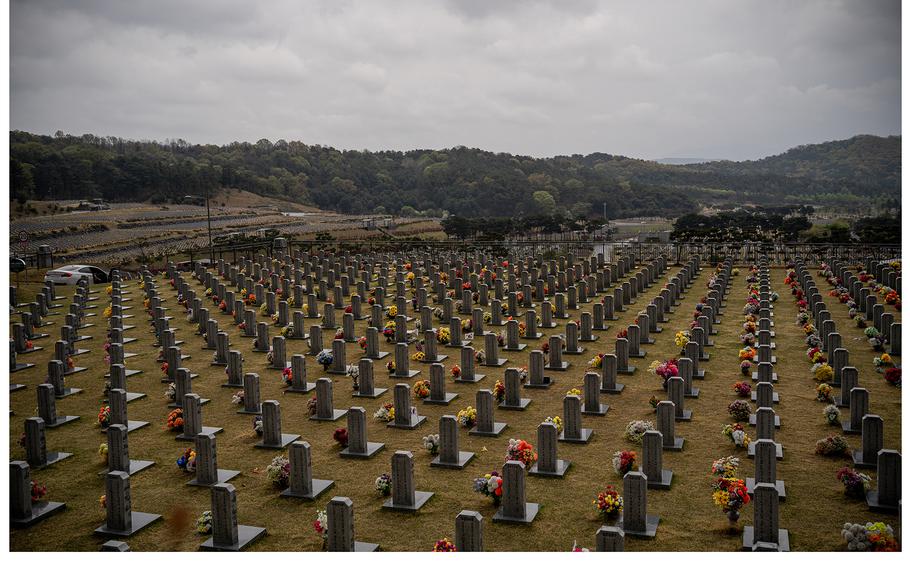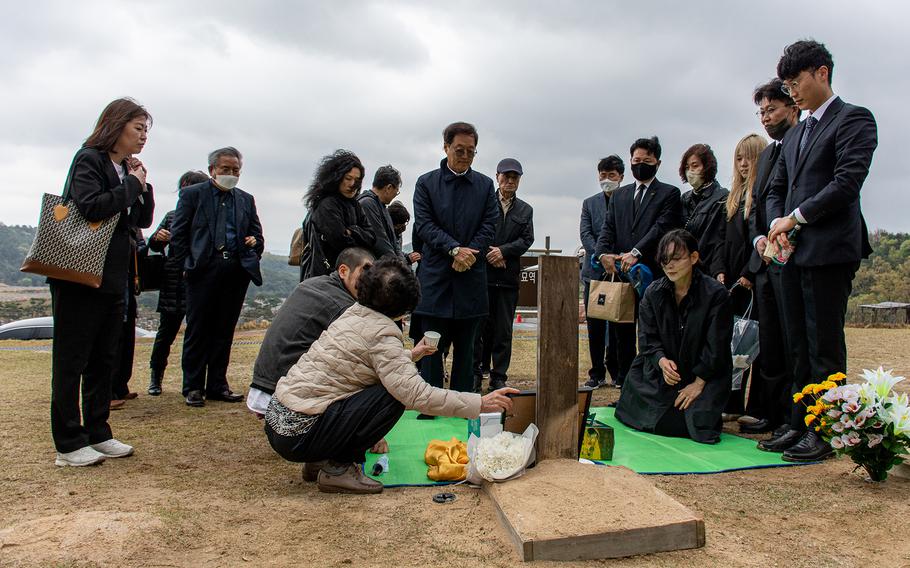
A portrait of Lee Jong-wook sits in front of his burial site at Daejeon National Cemetery in South Korea. (Tina Hsu for The Washington Post)
BUSAN, South Korea — You never expect to meet an ancestor. Not in person, at least.
But I did. My great-grandfather was tall for his time. I discovered this when gravediggers assembled his skeleton at my feet earlier this year.
For 57 years, Lee Jong-wook had been buried on a small plot of family land in Busan, at the southeastern tip of South Korea. In life, he had been deemed a dangerous renegade, a Korean independence activist who posed a security threat to the peninsula’s Japanese occupiers and was imprisoned. But this year, he was recognized for his patriotism, and his body was moved from the family plot to the national cemetery, with full honors.
With the approach of his reburial, I set out to learn about him - and, along the way, discovered how his life and mine bookend a century of a uniquely Korean existence.
On this peninsula, every family has tales that span the dramatic modern history of the Koreas - from Japanese colonization, which ended in 1945, through to the division of one Korea into two. The North turned to communism and poverty, the South to democracy and relative wealth.
That applies to my family, too.
My great-aunt was one of many teenage girls in the 1930s and 1940s who were married off early to avoid being coerced by Japan’s Imperial Army into sexual slavery.
My mom’s parents were among the flood of migrants who fled the North as the Korean War broke out in 1950, with many families split up in the chaos. The war ended in an armistice in 1953, and the Koreas remain separated. My grandfather was separated from his brother and never saw him again.
My parents were married on a day that would turn out to be pivotal to South Korea’s democratization. Hundreds of thousands calling for an end to military-directed government staged protests on June 10, 1987, that ultimately toppled the regime.
I was born in Seoul the summer it hosted the 1988 Olympic Games, an event that symbolized South Korea’s democratic and economic transformation.

Daejeon National Cemetery. (Tina Hsu for The Washington Post)
As a Korean American - my family immigrated to Guam when I was 7 - I have never felt fully Korean, nor have I wanted to. Being a diasporic Korean means living between cultures, where I feel most myself. As an American news reporter who renounced Korean citizenship, I now live between Tokyo and Seoul, documenting the lives of those my great-grandfather stood for and against. My life would have been unimaginable to my great-grandfather, who had been willing to die for his Korean identity.
Yet our generational arc is a reflection of Korea’s rapid evolution through the 20th century. I wanted to explore his legacy.
I asked my dad for his grandfather’s name and plunged deep into the archives, finding oral histories and handwritten sentencing documents. Then I took a train to Cheonan, south of Seoul, where century-old letters and documents were on display at a museum dedicated to the independence fight. There, I learned of his place in the movement’s history.
Although Imperial Japan formally annexed Korea in 1910, it had been steadily exerting control over the peninsula for years before that, while my great-grandfather was a child. Harsh colonial rule - from banning spoken Korean in schools to drafting people to work in poor conditions in Japan - gave rise to a simmering resentment and an underground resistance network.
It boiled over on March 1, 1919, when independence activists staged a rally. They produced preoccupation Korean flags from memory and wrote a Declaration of Independence that established a provisional government.
The occupation continued for 26 more years, but the rally sparked a national grass-roots protest movement and marked an important turning point in the Korean psyche. To this day, South Koreans mark March 1 with a public holiday and a celebratory reenactment of the marches.
That year, my great-grandfather was a 22-year-old living in Ulsan, a small southeastern town noted for its fiery patriotism and its proximity to Japan, just 150 miles across the sea. He and fellow members of a secret youth activist group had heard about the rally and wanted to organize one of their own.
One April evening, about 20 young men unfurled a sheet of white silk and bit down on the middle fingers of their right hands until they drew blood. With that blood, they signed an agreement to sacrifice their lives to the cause of liberating Korea.
“Long live the independence of Korea,” they yelled. Or in Korean: “Mansei!”
Like many other rallies across the country, theirs turned violent. Startled Japanese police officers scrambled to call in reinforcements, according to archival records. They brawled with the protesters and, wielding their bayonets, dispersed the crowd.
Five people died in fights with police, according to Korean records. After my great-grandfather and 13 other instigators were arrested, their friends continued the protest the next day.

The Lee family gathers around Lee Jong-wook's burial site at Daejeon National Cemetery. (Tina Hsu for The Washington Post)
On July 12, 1919, the Ulsan High Court found my great-grandfather guilty of violating the National Security Act and he was sentenced to two years in prison. It did not change his stance. Upon his release, he established a training center to help preserve Korean identity.
His death in 1966 was as fierce as his life. After being diagnosed with a terminal illness, he starved himself so he wouldn’t be a burden to his family. He was buried on the small plot of family land in nearby Busan.
As South Korea progressed toward democracy, independence activists came to be seen in a new light. Around 1980, my great-grandfather posthumously received a presidential commendation, and in 1990, the Order of Merit for National Foundation.
The final and highest honor came when the government decided he belonged among the war heroes and esteemed public servants at Daejeon National Cemetery, South Korea’s version of Arlington.
He was to be reburied on April 11, 2023. I wanted to be there.
Asking the spirits for permission
The spring morning of his disinterment was too cold for a jacket but too warm for a coat. (I chose a jacket, which I regretted for many hours.) The family of my great-uncle, the only surviving son at 88, was handling the day’s tasks, and I had asked to join for this story. At sunrise, we drove to my great-grandfather’s hillside grave.
The next morning, they launched their protest with their call sign: a soccer ball, kicked into the air. As the men raised their homemade flags and called for liberation, more than 100 other Koreans joined in.
We met with two Buddhist monks in gray robes and began the hike up a steep path, surrounded by thin trees that towered over us. We carried boxes filled with food, in the Buddhist tradition, to serve to the dead: pears, apples, fish, chestnuts, rice, vegetables and jeon (fritters).
For two hours, the monks recited rhythmic blessings and prayers, keeping the beat with a wooden block. They lighted incense and sought permission from the mountain’s spirits before disturbing the land. They blessed my great-grandfather’s soul ahead of his move.
I wasn’t too familiar with the Buddhist rites because after my family immigrated to Guam, we no longer attended ancestral ceremonies in South Korea.
That day in April, I participated for the first time, bowing and listening to prayers. I caught a waft of incense as I grasped a paper cup of soju (Korean rice liquor) with both hands, rotated it clockwise, then poured it onto the grave as a sign of respect and blessing.
After the ceremony, my relatives hiked down the hill because, in Buddhist practice, it is considered disrespectful to witness an ancestor’s burial ground being disturbed. But I wanted to stay - I needed to, for my story. I made my case to the head monk, and he let me stay.
Three gravediggers arrived in jeans and T-shirts for a routine workday, smoking cigarettes and chitchatting about the quality of the soil.
As they shoveled, I thought about something I’d learned that morning about my great-grandfather’s personality: His anger at injustice would ignite like wildfire, my great-uncle told me. I recalled episodes of my own righteous outrage - starting at age 7, when I cursed out a playground bully. Maybe I inherited some of the embers of his fury.
Then, a gravedigger stepped into the hole in the ground. I braced for an aged wooden coffin to emerge.
Instead, out came a femur.
My great-grandfather’s body had been decomposing directly into the soil. The crew plucked out his bones by hand and assembled his skeleton in front of me as if we were at an archaeological site.
I hadn’t even known his name until earlier this year. Yet I suddenly knew him by his bones. His teeth were still embedded in his jaw. Much of his rib cage remained. His foot bones rattled in rotting brown socks. I could imagine him lying there, in the flesh.
What would he think of me? I chose to learn Japanese, the language he was forced to speak. The two countries are now trying to move past historical baggage from the colonial period, and I’m covering their effort as an American. If he knew all this, would his anger once again burn? Or would he understand?
The workers wrapped up his bones in white cloth and draped a South Korean flag over them.
I joined up with my relatives and we went to the cremation center together. I stood next to my great-uncle and watched his father’s remains go into the incinerator. We bowed until its doors closed, and then waited as his bones were transformed into fine ash. On my periphery, I saw my great-uncle wipe a tear with his handkerchief.
“How do you feel?” I asked him after the cremation.
“There’s nothing to feel,” he said. “Life is so futile. So futile you could cry.”
We delivered the urn to the temple. The next day, we would take my great-grandfather to his final resting place.
A legacy lives on
This April was a yoondal, or a “leap month,” in the lunar calendar. It is considered an auspicious time for destabilizing life changes - moves, renovations, reburials.
At Daejeon National Cemetery, south of Seoul, honor guards marched in stilted unison, and my family and others sent off our loved ones with prayers and white chrysanthemums. All we knew of the seven others buried that day were their names and the names of their spouses. I wondered if any of them had a story like my great-grandfather’s.
In South Korea, there is a saying that independence activism ruins three generations. Many activists were imprisoned and struggled to get jobs because of espionage charges or physical torture, and were unable to afford educations for their children. Others burned through savings to fund their cause or died in prison. Some families still depend on government subsidies meant to compensate them for their sacrifice.
Unlike the excavation the previous day, the reburial was a major family affair. More than two dozen of us in the second, third and fourth generations gathered, including my parents, who’d flown in from Guam.
We each shoveled dirt on my great-grandfather’s new grave and said goodbye. My dad repeated the ritual I had performed the day before: He served a cup of soju, rotated it clockwise, poured it on the fresh earth.
A legacy is a memory, the kind we hope will transcend our time and, if we’re lucky, live on for more than a few generations after us.